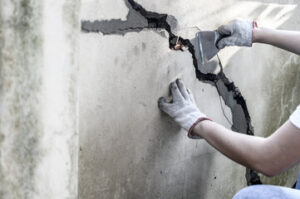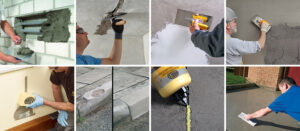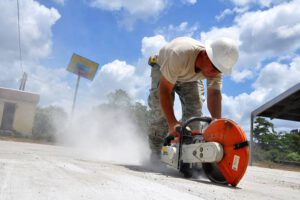Concrete is one of the most used and most durable building materials, but when it gets damaged or worn down, repairs are necessary. These repairs can be structural or cosmetic and take various forms.
Many repair methods require a long moist-curing time, but there are other rapid-repair options. Contact Concrete Repair Eau Claire for professional help.
Concrete surfaces can be damaged by water, ice, poor construction practices, ground movement and a variety of other factors. When this damage occurs, it must be repaired promptly to prevent further damage and potential structural problems. Depending on the severity of the damage, surface repairs can be made using a variety of methods.
Surface crack repair involves filling in or sealing the crack to restore the concrete to its original condition. This type of repair is typically not permanent and may require maintenance over time. It is also important to address any factors causing the cracking in the concrete, as this will help prevent future occurrences.
Uneven surface texture, pits and dips can be corrected with a concrete leveling product. This is ideal for repairing and smoothing concrete slabs, driveways, sidewalks, steps and walls. It is important to ensure the concrete is dry and structurally sound before applying a concrete leveling product.
Aside from being unsightly, uneven concrete can cause tripping and other safety hazards for those walking on the surface. Additionally, it can lead to the growth of mold and mildew that can be harmful to human health. Concrete leveling products can be used to correct these issues, restoring the surface to its original uniform appearance and making it safe to walk on again.
Unsightly stains can be removed from the surface of concrete with stain-fighting chemicals or power washing. This is especially common in commercial areas, where the use of chemical-based stain removers helps to maintain a professional and sanitary environment for employees and customers.
If surface stains are not addressed quickly, they can detract from the overall look of a building or area and make it unappealing to visitors or clients. The good news is that these stains are usually easy to remove and can be restored to their former glory with proper cleaning and surface preparation.
Concrete replacement is a method of concrete repair that involves replacing the existing concrete with new material. This is typically only done when the damage extends beyond the reinforcement structure in walls or floors, and it can be a desirable solution to honeycombing or other large sections of damage that are impossible to repair with surface cracking techniques. When concrete is replaced, it is vital to have a low sand: cement ratio in the mix to minimize shrinkage cracking.
Structural Repair
Structural repair involves repairing damage to concrete structural members such as beams, columns, slabs and walls. Depending on the severity of the damage and the type of structure, different repair methods can be used.
Concrete repairs involving structural elements require expert knowledge and skill, which only qualified professionals can provide. Repairing structural members of a concrete structure requires consideration of the design load and ensuring that the repaired member is strong enough to perform its intended function. This is especially important for bridges and other large structures where a failure could result in loss of life or property.
There are several methods of concrete structural repair, including epoxy injection and grouting. Epoxy injection can be used to fill in thin cracks in concrete, and can be a good option for concrete repairs requiring minimal disruption to the structure. However, it is important to identify the source of the crack in order to ensure that it does not reappear after the epoxy has cured.
Another method of concrete structural repair is to use the drilling and plugging technique. This method involves drilling a hole into the side of a concrete crack, then filling the holes with grout, which acts as a plug to prevent the crack from expanding further.
This type of concrete repair can be particularly useful for repairing cracks in concrete floors, since it is quick and relatively inexpensive. However, it is important to ensure that the crack is clean and dry before using this method, as moisture can lead to further deterioration of the concrete.
If the concrete is so badly damaged that it cannot be repaired with epoxy injection, it may need to be removed and replaced. If this is the case, it is important to stabilise the structure by shoring prior to removal, and to remove any reinforcing steel that has been corroded. In the event that a structural member is beyond repair, it can often be replaced with new steel and concrete.
A good concrete contractor will know how to identify the appropriate repair method for the specific situation, and will have access to high-quality materials and equipment. They should also be able to recommend preventative maintenance measures that can help to minimise future damage.
Routing and Sealing
Concrete cracks and damage may be caused by a number of factors. Regardless of the cause, it is important to address the problem promptly to prevent further deterioration, and potentially costly repairs in the future. This includes proper surface preparation and the use of bonding agents to improve adhesion. Concrete repair procedures can also include routine cleaning, the addition of drainage systems, the use of concrete sealants and the implementation of a preventative maintenance program.
Structural cracks often require more advanced and expensive repair methods, such as epoxy injection. This process involves drilling holes at close intervals along the crack, installing entry ports and injecting epoxy under pressure. This method can be used to repair both active and dormant cracks. It is a permanent structural repair and can be applied to both new and old concrete structures.
Injection is a common solution for repairing structural cracks, but it can be used in conjunction with other methods of concrete repair. Another popular repair method is grouting or stitching. This method of repair consists of drilling holes the length of the crack and then filling it with grout. This creates a grout key that limits the movement of surrounding concrete sections and can reduce leakage through the crack.
For small and shallow cracks, routing and sealing is an inexpensive and quick repair method. This procedure involves using a routing tool to cut a V-shaped groove along the surface of the crack. The groove is then filled with a joint sealant. This method of repair is not recommended for major cracks and should be avoided if water leakage cannot be controlled.
Chemical exposure, freeze/thaw, mechanical loading, seismic events and corrosion of embedded reinforcing steel are some of the leading causes of concrete deterioration. This type of deterioration is common in both residential and commercial buildings, but can occur in any structure that has been exposed to these conditions for an extended period of time. CRI offers a variety of long-term concrete repair solutions to prevent deterioration and protect existing concrete. These services are designed to restore the original strength, durability and appearance of existing concrete.
Decorative Repair
Concrete contractors can also make decorative repairs to improve the look of existing concrete. This is especially helpful if your concrete has become damaged by cracking or staining. Decorative concrete repair is often less expensive than replacement and can be completed within days.
There are several different types of decorative repair materials, from tinted epoxy to stains and dyes that penetrate the concrete and color it. Regardless of the material, the process begins with thoroughly cleaning the area to remove dirt and debris. Then, the surface is prepared with a grinder such as the Onfloor 16. Finally, the selected material is poured and leveled over the surface.
Decorative concrete repairs can take anywhere from hours to days to complete, depending on the size of the job and type of repair needed. It is best to have a professional contractor do the work to ensure it is done correctly, efficiently, and safely. This will help you avoid costly repairs in the future.
When choosing a concrete repair contractor, it’s important to find someone with experience and expertise. You should also be able to see examples of their previous work. Asking around and checking online reviews can be a good way to get an idea of the quality of the work and customer service provided by the contractor.
It’s also essential to use high-quality products for your concrete repairs. This will ensure that your repair is long-lasting and durable. Using the correct products for each type of repair will also save you time and money in the long run.
Cracks in concrete are inevitable, but they don’t have to be permanent. Whether the cracks are structural or aesthetic, it’s important to address them as soon as you notice them. Not only will this prevent the cracks from widening, but it will also improve the look of your concrete and protect against further damage.
To determine the best repair method for your concrete, it’s critical to understand the cause of the damage. Once this is determined, you can choose the appropriate repair method and implement preventative measures to keep your concrete looking great.

